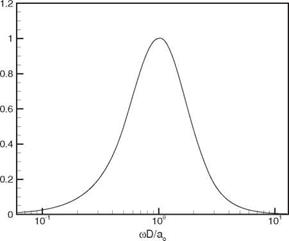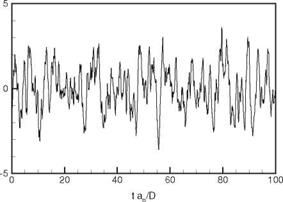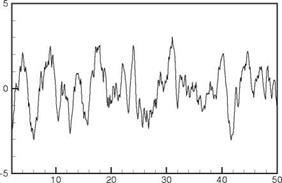Generation of a Random Broadband Acoustic Field
Many aeroacoustics problems involve noise generated by turbulence. For this class of problems, both the source and the sound field are random and consist of a broad spectrum of frequencies. This is the case of high-speed jet noise. At a high Reynolds number, the jet flow is turbulent with a wide range of length scales. The noise emitted is broadband typically spread over three decades of frequencies. At the present time, there are not enough computational resources to perform direct numerical simulations of the jet flow. Many investigators choose to use large eddy simulation (LES) as an alternative, but the computational domain is finite and often is minimized to reduce computational cost. For this reason, without exception, only the acoustic near field is computed. However, for community noise purposes, interest is in the far field. Therefore, a method capable of continuing broadband near acoustic field to the far field is very much needed.
In Appendix F, a method to produce real-time pressure waves from a random broadband noise source is described. For a broadband monopole source, the acoustic field generated is spherically symmetric. Consider such a localized source as shown in Figure 14.12. Suppose the noise spectrum S(s-D) is given where D is the length scale and a0 is the speed of sound. The sound field emitted by the monopole source following Appendix F is as follows:
(Ю

![]() p(Y, t) = — A(m) cos
p(Y, t) = — A(m) cos
![]()
|
|||
|
|||
 |
|||
|
|||
|
|
||
|
|||
|
|||
|
|||
|
|||
|
|||
|
|||
|
|||

Figure 14.18. Time history of pressure fluctuations at Y = 5D from the broadband monopole noise source of Figure 14.17.

 |
|
The two-point space-time correlation function of the broadband sound field of a monopole source, following Eq. (F5), is given by
where the overbar means the time average. The function F(Y2 YD a°) can also be computed directly from the acoustic field of the monopole source, that is,
Y — Y —a t
Figure 14.19 shows the two-point space-time correlation function F ( 2 d 0 ) as computed directly according to Eq. (14.92). As a check on the accuracy of the energy – conserving discretization method and this formulation, the noise spectrum S(^D) is calculated by taking the Fourier transform of F(D), obtained by setting Y1 = Y2. This should yield the original prescribed similarity spectrum. A comparison of the two spectra is given in Figure 14.20. This figure indicates that there is good agreement between the two spectra. This confirms that the energy-conserving discretization method can, indeed, generate a broadband sound field with a given spectrum.















